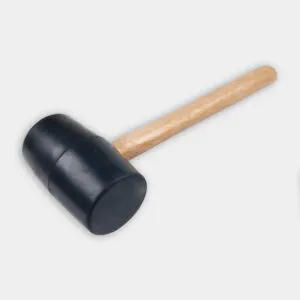We may be compensated if you purchase through links on our website. Our team is committed to delivering honest, objective, and independent reviews on home products and services.
Because of its easy-to-install interlocking design, tongue-and-groove flooring is a popular choice for DIY-minded homeowners. This flooring type offers a seamless look and a sturdy installation method that can last for decades when properly maintained. This Old House general contractor Tom Silva demonstrates the installation process with host Kevin O’Connor, showing the best techniques to use for a professional-quality result.
What Is Tongue-and-Groove Flooring?
Tongue-and-groove flooring is a system in which planks have a protruding “tongue” on one edge and a corresponding “groove” on the opposite edge. This design allows the boards to interlock easily, creating a tight seal and a smooth surface with minimal installation work required.
Tongue-and-groove flooring can be installed over various subfloor. When properly installed, it can withstand heavy foot traffic for years. The interlocking system provides excellent structural support.
Tongue-and-Groove Flooring Types
Tongue-and-groove flooring comes in many types. Each has unique advantages, so consider your needs and preferences when choosing the best option for your home.
- Bamboo: An eco-friendly and durable option, bamboo flooring is a good choice for environmentally conscious homeowners.
- Engineered wood: Designed to be more resistant to moisture and temperature fluctuations, engineered wood flooring offers enhanced stability in various climates and conditions.
- Laminate: A budget-friendly choice, laminate flooring is easy to maintain and provides a wide variety of styles that mimic more expensive materials.
- Solid hardwood: Known for its traditional appeal and longevity, solid hardwood flooring offers a timeless look and can last for decades with proper care.
Tongue-and-Groove Flooring vs. Other Flooring Types
Tongue-and-groove flooring stands out because of its interlocking system, which creates a more stable and unified floor. Unlike traditional planks that may require significant nailing or adhesive, tongue-and-groove flooring typically uses fewer fasteners.
This type of flooring can be more forgiving of minor imperfections in subfloors. The interlocking design distributes weight more evenly, reducing the risk of gaps or uneven boards over time.
Preparing for Tongue-and-Groove Flooring Installation
Before you start installing your tongue-and-groove flooring, make sure you have everything you need and that the flooring and subfloor are prepped.
Gathering Tools and Materials
Gather the following tools and materials:
- Caulking gun
- Chalk line
- Construction adhesive
- Finish nails
- Finish nailer
- Flooring jack
- Flooring nailer
- Flooring staples
- Miter saw
- Pencil
- Rubber mallet
- Shims or spacers
- Tape measure
- Tongue-and-groove flooring
- Wood putty
Acclimating the Flooring
Before installation, allow the flooring to acclimate to the room’s temperature and humidity for at least 48 hours. This helps prevent warping or gaps after installation. Place the boards in the room where they will be installed and spread them out. They shouldn’t be stacked tightly together, or they won’t acclimate properly.
Preparing the Subfloor
Ensure the subfloor is clean, dry, and level. Address any imperfections or unevenness before installing the flooring. Thoroughly sweep and vacuum the area to remove any debris that could affect the installation process.
Flooring Installation Process
Follow these steps to install your tongue-and-groove flooring.
Starting the First Row
Begin by marking the first row. Place a board against the wall, leaving a 3/16-inch gap for expansion. This gap will allow the wood to expand and contract with changes in temperature and humidity.
Snap a chalk line to ensure a straight starting point. This line will guide the placement of your first row of boards. Apply construction adhesive between the chalk line and the wall for the first row only. This will help stabilize the initial row of flooring. Align the tongue of the first board with the chalk line and face-nail it along the groove side. This step anchors the board securely in place.
Laying Subsequent Rows
For a stronger floor, stagger the end joints of adjacent rows by at least 6 inches. This adds stability and prevents weak spots.
Use a flooring nailer to secure boards through the tongue at a 45-degree angle. Nailing at this angle ensures that the nails are hidden and the boards are tightly connected. Tap boards into place with a rubber mallet before nailing. This ensures a snug fit between the boards. Silva recommends nailing anywhere between 8, 10, and 12 inches apart.
Continue this process across the room, checking for straightness periodically. Use a straightedge or long level to ensure that the rows remain aligned. As you progress, you’ll develop a rhythm, and the installation process will become more intuitive. Take your time to avoid mistakes.
Cutting and Fitting Boards
When cutting boards to fit, measure the space needed, accounting for the expansion gap. Mark the board, ensuring the tongue is oriented correctly. Align your cut marks with the tongue side of the board. Cut the board using a miter saw for clean, precise cuts. A sharp blade will minimize splintering. Install the cut piece, ensuring a snug fit with adjacent boards. Use a rubber mallet to gently tap it into place.
Adjust your cutting technique based on your room’s specific layout and design. Rooms with complex shapes or irregular walls may require additional precision.
Adjusting for Obstacles and Room Transitions
During the installation, you may encounter obstacles such as doorways, vents, or other structural elements. Adjusting for these features requires careful planning and precise cuts. Measure the area around the obstacle and cut the flooring to fit snugly.
For room transitions, consider using transition strips that match your flooring. These strips provide a smooth transition between different types of flooring or between rooms with varying floor heights.
Tongue-and-Groove Flooring Finishing Touches
After installation, a few final steps will give you a professional-quality finish.
Filling Nail Holes
Use wood putty that matches the color of your flooring to fill any visible nail holes. Once dry, gently sand the filled areas for a smooth finish. This step makes the flooring look more professional and seamless.
Installing Baseboards and Trim
Install baseboards and trim to cover the expansion gaps around the room’s perimeter. This gives the floor a polished, finished look. Nail the trim into place and ensure it sits flush against the wall and floor. Use a caulking gun to fill any gaps between the trim and the wall.
Cleaning and Maintenance
Clean the newly installed floor thoroughly to remove any dust or debris. Follow the manufacturer’s recommendations for ongoing care and maintenance. Regular cleaning will extend the life of your flooring and maintain its appearance.
Dealing With Common Problems
Even with careful installation, issues such as squeaky boards or minor gaps may arise. Address squeaks by applying a small amount of wood glue or construction adhesive to the affected area, then re-nail if necessary. For gaps, consider using a wood filler or installing additional shims to tighten the fit.









